
Researchers aboard the R/V Neuston testing water clarity on Crater Lake.
Juliet Grable / JPR News
On a warm August day, aquatic biologists Scott Girdner and Josh Sprague lie prone on the deck of the research vessel Neuston. Holding life jackets tented over their heads to block the sun’s glare, they gaze into the sapphire depths of Crater Lake, Oregon’s only national park. As they stare, Biological Science Technician Nate Akers operates a cable that lowers a black and white disk deep into the water.
“I’m out!” Sprague calls out, when he can no longer see the disk. Akers lowers the disk a few more meters, then starts pulling it back up.
“Out!” Sprague shouts again, once it comes into view.
This simple but elegant exercise, called the Secchi depth test, is used to measure the transparency of this incredibly clear, incredibly blue lake. The greater the depth at which a person can see the disk, the clearer the water.
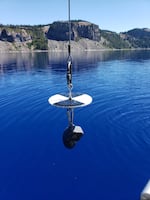
The Secchi disk is a simple but elegant tool used to measure the clarity of waterbodies like Crater Lake.
Juliet Grable / JPR News
The Secchi test is part of a comprehensive ongoing monitoring at Crater Lake. Launched in 1983, the program is invaluable for helping scientists track trends in the lake’s chemistry, climate, and biology.
While much of the monitoring is conducted from the Neuston, remote equipment enables monitoring to happen year-round, including when the lake is ringed with tall snowdrifts. A permanent weather buoy measures temperature, humidity and wind speed. Sensors in the water track temperature and oxygen. And since 2013, a special “profiling instrument” crawls up and down a wire anchored to the lake bottom, collecting data on water chemistry and organic matter.
Crater Lake’s depth and clarity are key to its brilliant color, and one of the reasons thousands of visitors are drawn to the national park every year. But as a metric, clarity also helps scientists like Girdner gauge other aspects of the lake — the density of tiny aquatic plants, for instance, which provide food for tiny creatures.
“Clarity touches everything,” says Girdner, who coordinates the monitoring program.
That day, Girdner and Sprague could spot the disk up to about 27 meters, or 88 feet, which is close to average. Though it fluctuates from year to year, the clarity of Crater Lake has remained uncompromised for decades. But other changes are afoot, many of them wrought by a warming climate. Some of these changes have profound implications for the lake’s ecology — and perhaps for its iconic appearance.
On deck, after the Secchi test, the team collected water samples at various depths using special bottles lowered into the lake with a long cable. After taking the samples they needed, Sprague emptied the bottles, but not before everyone had filled their flasks with cold, delicious snowmelt from the lake’s depths.
“It’s about as clean as you can get,” says Girdner.
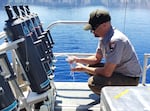
Aquatic biologist Josh Sprague collects a water sample from special sampling bottles that are lowered into Crater Lake at different depths.
Juliet Grable / JPR News
Sampling springs
Later that afternoon, Sprague and Mark Buktenica, Crater Lake’s long-time aquatic ecologist, motor off in a smaller, aluminum research boat to take water samples from several of the springs that feed into the lake.
Sprague guides the vessel around Phantom Ship, a formation of jagged basalt columns that erupt from the lake to form a small island. Large rainbow trout flash in the shallower water, which is colored in shades of aqua and teal. Less than 30 feet out from the island, the depth plunges suddenly, and the water deepens to a breathtaking dark blue.
Sprague motors to the shore and ties the boat off to a rock. Above, a thin ribbon of water plunges down the steep slope from the crater’s rim. Flowers and shrubs cling to the wet rocks, and dragonflies dart around the spring. The scene evokes a kind of paradise, and it’s easy to forget scientific monitoring is taking place. Buktenica, who officially retired in 2018, is training Sprague on some of the many sampling protocols.
Buktenica spent his entire career at Crater Lake, starting with graduate work in the early 1980s. He joined the staff in 1985, when the monitoring program was in its infancy, and coordinated the program for three decades. Even now, Buktenica has a hard time staying away.
“It’s the water, the color — it just blows me away,” he says.
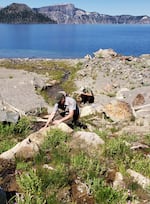
Biologists Josh Sprague and Mark Buktenica sample some of the many springs that empty into Crater Lake.
Juliet Grable / JPR News
Crater Lake formed approximately 7,700 years ago, after a spectacular eruption of then-Mount Mazama. The caldera left in the aftermath slowly filled with rain and snow. Today Crater Lake is the second deepest lake in North America. It’s a closed basin: the only inputs are rain and snow, most of which fall directly into the lake itself. No streams flow out of the lake; instead, water is lost almost exclusively through evaporation.
In the early 1980s, biologist Douglas Larson noticed a trend of declining clarity and sounded the alarm, worried that a spring contaminated with sewage was compromising water quality. That turned out not to be the case — clarity naturally fluctuates from year to year — but it sparked the creation of the long-term monitoring program.
Over the years, the program has grown, and staff regularly collaborate with researchers from various universities and the U.S. Geological Survey. The program has yielded decades-long data sets on weather and climate, the lake’s physical and chemical properties, and the aquatic plants and creatures, large and small, that call Crater Lake home.
Even though the lake sees well over half a million visitors from all over the globe each year, it is one of the most pristine lakes in the world, compared to other deep freshwater lakes such as Lake Tahoe. One reason to sample springs is to keep tabs on any nutrients all this human traffic might be bringing into the lake.
“If you aren’t looking, you don’t know if the lake is going to hell,” says Buktenica.
Invasive crayfish and blooming algae
A worrisome event that took place last summer is clouding the lake’s future. In late July 2021, long fluorescent green strands of algae sprouted from the rocks along the shoreline, coloring swaths of water in places.
“Wizard Island looked like someone took a highlighter to the shoreline” says Girdner, referring to the lake’s other, larger island. Because the COVID pandemic had grounded boat tours to Wizard Island that summer, few visitors witnessed the bloom, and the event didn’t cause as much alarm as it could have.
Climate change is at least partly to blame. Warm water favors algae growth, and surface water temperatures on the lake have increased some 6 degrees Fahrenheit since 1965. Last summer, the lake’s surface temperatures soared to an average of over 63° Fahrenheit during July — the hottest on record.
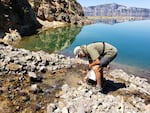
Aquatic ecologist Mark Buktenica measures the temperature of a spring that feeds into Crater Lake.
Juliet Grable / JPR News
Girdner thinks an invasive species of crayfish may have made matters worse.
Crayfish were first released into Crater Lake in 1915 — ironically, to feed trout and kokanee salmon that were also introduced. The voracious crustaceans eat insects and snails — the very grazers that consume algae — and they’re quickly taking over Crater Lake’s shoreline. Girdner notes that, although it’s not a perfect correlation, the long-stranded algae tended to grow in places where crayfish are abundant.
For nearly 100 years, the crayfish were a minor presence in Crater Lake. In 2008, when the lake research team began counting them during annual snorkeling surveys, they found crayfish at about half of their sites. This year, they found them just about everywhere along the shore. (Crayfish “go deep,” too, says Girdner, noting that they have caught them as far as 200 meters below the lake’s surface).
Climate change may be fueling the population boom.
“When it gets really cold in winter, there are fewer crayfish the next summer,” says Girdner. But the lake hasn’t been getting as cold in winter lately, and the U.S. Geological Survey predicts the warming trend will continue.
More crayfish also spell bad news for the Mazama newt, a drab, pebbly-skinned amphibian that lives in Crater Lake, and nowhere else. The shy newt is a subspecies of the rough-skinned newt, but while rough-skinned newts are highly toxic, Mazama newts are not. At one time they were the top predator in Crater Lake.
Now, crayfish prey directly on the newts. They also compete for their food and alter the newts’ behavior by driving them out from under rocks and forcing them to swim, where they are more vulnerable.
“If you’re a newt in the water column during the day, this is what’s going to happen to you,” Girdner told me, showing me a picture of a dissected rainbow trout stomach that contained five newt skeletons.
Unfortunately, once established, crayfish are virtually impossible to eradicate. Unless some new technology emerges to control them, they are here to stay, which means the Mazama newt is likely on the path to extinction.
“We’ll probably be looking at capturing newts and finding a zoo to keep and breed them,” says Girdner. But, he wonders: if Mazama newts are only living in a zoo, not in their native habitat, are they even Mazama newts anymore?
This summer Girdner and his fellow biologists have been scanning the shoreline closely for signs of another algae bloom. So far, it hasn’t manifested. They are working with U.S. Geological Survey researchers to develop new monitoring projects to better understand the interactions among plants and creatures that live near the lake’s shore.
A changing ecosystem
While the algae bloom may be the most startlingly visible sign of climate change, other trends are coming to light because of the monitoring program. Yet these changes have dramatic implications for the lake’s ecology.
Warmer temperatures are affecting an important climate-driven phenomenon that happens in winter. During cold months, a thick layer of cold water forms on the top of the lake and is key to a process called deep-water mixing: winter storms drive the cold surface water, which is rich in oxygen, down to the bottom of the lake, forcing warmer water up toward the surface. This warmer water contains nitrates — the primary source of nutrients in the lake — which are consumed by algae.
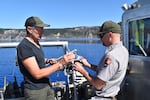
Aquatic biologists Scott Girdner (left) and Josh Sprague prepare a water sample at Crater Lake that will help them measure how quickly algae grows.
Juliet Grable / JPR News
In recent winters, the cold layer hasn’t been forming as regularly, and the “mixing events” have been happening less frequently. Modeling suggests they could cease altogether.
“Mixing is part of a normal cycle that drives life in the lake; it sets up everything: chemistry, clarity, biological productivity,” says Buktenica. “If you cut that out, it’s about as drastic change as you’re going to get.”
Buktenica and Girdner can’t predict exactly what will happen if the deep-water mixing events stop. The lake might even become clearer, at first. But because oxygenated water isn’t being pulled down to the bottom of the lake, a “dead zone” could form there, which could spur fish kills when the oxygen-poor water is finally released upward.
The mission of the National Park Service is to preserve “unimpaired the natural and cultural resources and values of the National Park Service” for present and future generations. Crater Lake is a national treasure. If anything threatens its iconic clarity, the monitoring team will be there to track it — and, if the threat is human-caused, to help mitigate it, if possible.
While the startling changes the monitoring team are tracking are a sober reminder that even cherished and protected places may be touched by climate change, they also underscore the importance of the monitoring program, and the value of having decades of data to help put these trends in context.
But there’s another reason to keep tabs on Crater Lake, says Buktenica.
“Virtually all of the large lakes in the world suffer multiple impacts from local, regional, and global development, making it more difficult to tease out the specific impacts from any one issue,” says Buktenica. Because Crater Lake is so pristine, it can be used as an early warning system, helping researchers detect and study large-scale and global issues that are likely affecting other waterbodies, too.